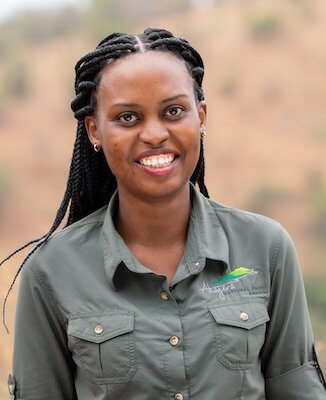As we continue exploring wildlife monitoring challenges across East Africa and the accompanying stellar conservation technologies and tools that have been developed and adopted to promote tracking and monitoring of threatened wildlife (you can read more about this in our article here), we tell the inspiring story of Clementine Uwamahoro @clementineu whose story of success and excellence in the Conservation Tech landscape in Rwanda serves as a catalyst to motivate emerging young female conservation technologists across the region that they too can overcome barriers and silence naysayers undermining the important role women play in conservation technology.
Clementine Uwamahoro
Read on to see our interview with Clementine Uwamahoro as she takes us on a journey of her extraordinary daily conservation tech work.
_____________________
Tell us about yourself.
I was born in Huye District located in Southern Rwanda and the second city of Rwanda where I also did all my studies from primary to university. Being born in the city and having lived my whole life there, I didn’t have any experience with forests or wildlife but I was a very curious kid who wanted to know how things work which led me to self learn IT skills - all I knew was that I was so passionate about nature. Using technology in conservation is like living my dream. My involvement in conservation started through my graduate studies in Environment Management from the University of Rwanda. My conservation career started when I joined Akagera National Park as a GIS specialist, and l was promoted in African Parks to the Country Conservation Technology Manager after I earned my Master's in Engineering from the China University of Mining and Technology in Mineral Resource Exploration and Exploitation. In my free time I love reading, discovering new things and playing basketball.
What Wildlife Monitoring challenge were you confronted with that led to you adopting this technology?
The pressure from poaching due to limited livelihood opportunities and the impacts of climate change on ecosystems that may cause the displacement or loss of many species.
Tracking and monitoring the environment down to the level of an individual animal to stop illegal poaching and habitat destruction hence supporting responses to climate change using technology to preserve and rebuild the environment in innovative ways.
Could you talk us through a brief summary of the technology you're using?
African Parks in Rwanda is contributing to sustainable biodiversity conservation by being the hub that enables the testing and validation of technology advancements that are vital in protected areas management. For instance, technologies like sensors, camera traps, animal collars, EarthRanger and satellite technologies are enabling the survey, monitoring, and protection of 12,000 mammals and 500 bird savannah-adapted species in Akagera National Park, as well as 1,068 plants, 322 birds, 75 known mammals, and 13 different primates’ species in Nyungwe National Parks.
What challenges have you faced in this work, either with technology or otherwise?
The main challenge I met was underestimation. When I started people would tell me that I won’t succeed because that’s not a woman's job. Women pursuing careers in tech is nothing new in Rwanda, but my job is unusual, as it involves the intersection of technology and conservation and takes me deep into the wilderness. When I am not sitting at a desk monitoring animal collars and their movement or keeping a lookout for security breaches, I am climbing transmission towers in need of repair. However, I find that part of my job very interesting, as it allows me to show people that women can do this work, too.
Are there lessons from your work so far that other WILDLABS members could apply to their own Wildlife Monitoring conservation technology work?
Many incredible solutions already exist but are not widely used.
Conservation technology covers various digital solutions and devices, including networks, satellites, sensors, wireless systems and cameras that offer a real-time, data-driven approach to ecosystem protection. Many incredible solutions already exist but are not widely used, all it takes is one's passion toward technologies and protecting the motherland, understanding the importance of staying up to date with changes in technology. Ensuring to always be aware of new developments allows one to stay informed about the latest trends and advancements in the field and have a network of peers who are also working in this field, to share ideas and resources with each other.
What other new technologies or innovations could make your work easier, enhance your results, or allow you to expand or further scale up your work?
Akagera’s eastern boundary with Tanzania is wetland complex that is challenging to secure. We are looking into introducing drones and acoustic devices to create a “virtual fence” along the park’s eastern boundary. This will contribute to the biodiversity goals of monitoring wetland species and biodiversity in this unique habitat. Rapid, real-time detection also will allow for focused reactions and more efficient interventions to ensure the park’s security.
_____________________
Clementine's story is a great example of the emergence of East African female conservation tech pioneers. Her story of resilience and excellence reinforces the importance of supporting early career women in conservation technology across the biodiverse Global South such as East Africa towards advancing their skill-sets and careers in conservation technology as WILDLABS continues to do through our Women in Conservation Technology Programme which you can read more about here.
If you'd like to learn more about Akagera and Nyungwe Parks visit the African Parks website here or connect with Clementine here on WILDLABS @clementineu
In the meantime, stay tuned on WILDLABS to meet more female East African conservation tech pioneers advancing wildlife monitoring systems across the region in new and innovative ways, and check out our article here for more information on other wildlife monitoring East African projects powered by conservation tech!
Thanks to Clementine Uwamahoro for talking with us about her work at Akagera and Nyungwe Parks and sharing photos of her conservation tech journey with the WILDLABS community!



Add the first post in this thread.